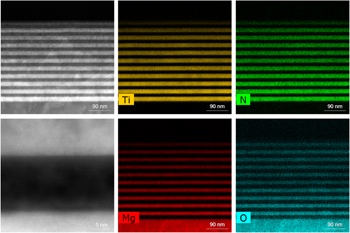Crossref Citations
This article has been cited by the following publications. This list is generated based on data provided by
Crossref.
Hohenberger, S
Lazenka, V
Temst, K
Selle, S
Patzig, C
Höche, T
Grundmann, M
and
Lorenz, M
2018.
Effect of double layer thickness on magnetoelectric coupling in multiferroic BaTiO3-Bi0.95Gd0.05FeO3multilayers.
Journal of Physics D: Applied Physics,
Vol. 51,
Issue. 18,
p.
184002.
Lorenz, Michael
Hohenberger, Stefan
Rose, Eduard
and
Grundmann, Marius
2018.
Atomically stepped, pseudomorphic, corundum-phase (Al1-xGax)2O3 thin films (0 ≤ x < 0.08) grown on R-plane sapphire.
Applied Physics Letters,
Vol. 113,
Issue. 23,
Lorenz, Michael
2019.
digital Encyclopedia of Applied Physics.
p.
1.
Templeman, Tzvi
Perez, Maayan
Friedman, Ofir
Abutbul, Ran Eitan
Shandalov, Michael
Ezersky, Vladimir
Konovalov, Oleg
and
Golan, Yuval
2019.
Layer-by-layer growth in solution deposition of monocrystalline lead sulfide thin films on GaAs(111).
Materials Chemistry Frontiers,
Vol. 3,
Issue. 8,
p.
1538.
Wei, Haoming
Yang, Chao
Wu, Yangqing
Cao, Bingqiang
Lorenz, Michael
and
Grundmann, Marius
2020.
From energy harvesting to topologically insulating behavior: ABO3-type epitaxial thin films and superlattices.
Journal of Materials Chemistry C,
Vol. 8,
Issue. 44,
p.
15575.
Hohenberger, Stefan
Lazenka, Vera
Selle, Susanne
Patzig, Christian
Temst, Kristiaan
and
Lorenz, Michael
2020.
Magnetoelectric Coupling in Epitaxial Multiferroic BiFeO3–BaTiO3 Composite Thin Films.
physica status solidi (b),
Vol. 257,
Issue. 7,
Yang, Liuqingqing
Heinlein, Jake
Hua, Cheng
Gao, Ruixia
Hu, Shu
Pfefferle, Lisa
and
He, Yulian
2022.
Emerging Dual-Functional 2D transition metal oxides for carbon capture and Utilization: A review.
Fuel,
Vol. 324,
Issue. ,
p.
124706.
Botha, N. L.
Cloete, K. J.
Welegergs, G. G.
Akbari, M.
Morad, R.
Kotsedi, L.
Matinise, N.
Bucher, R.
Azizi, S.
and
Maaza, M.
2023.
Physical properties of computationally informed phyto-engineered 2-D nanoscaled hydronium jarosite.
Scientific Reports,
Vol. 13,
Issue. 1,
Karunasena, Chamikara
Bjelobrk, Zoran
and
Risko, Chad
2023.
Atomistic Perspective of the Crystallization of Naphthodithiophene in Two Hydrocarbon Solvents.
Chemistry of Materials,
Vol. 35,
Issue. 17,
p.
6823.
Suchikova, Yana
Kovachov, Sergii
Bohdanov, Ihor
Konuhova, Marina
Zhydachevskyy, Yaroslav
Kumarbekov, Kuat
Pankratov, Vladimir
and
Popov, Anatoli I.
2024.
Wet Chemical Synthesis of AlxGa1−xAs Nanostructures: Investigation of Properties and Growth Mechanisms.
Crystals,
Vol. 14,
Issue. 7,
p.
633.
Chaulagain, Narendra
Alam, Kazi M.
Garcia, John C.
Vrushabendrakumar, Damini
Heger, Julian E.
Pan, Guangjiu
Kumar, Navneet
Rana, Md. Masud
Rajashekhar, Harshitha
Hooper, Riley W.
Kamal, Saeid
Michaelis, Vladimir K.
Meldrum, Alkiviathes
Müller-Buschbaum, Peter
and
Shankar, Karthik
2025.
Heteroepitaxial Growth of Narrow Band Gap Carbon-Rich Carbon Nitride Using In Situ Polymerization to Empower Sunlight-Driven Photoelectrochemical Water Splitting.
Journal of the American Chemical Society,
Vol. 147,
Issue. 13,
p.
11511.
